Phase 2
Co-Design methods
1. Google forms
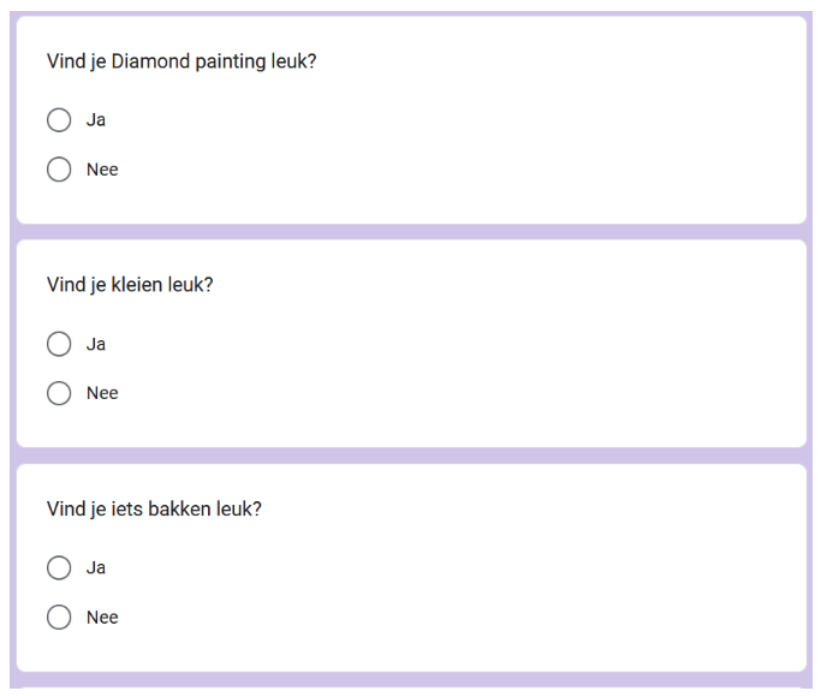
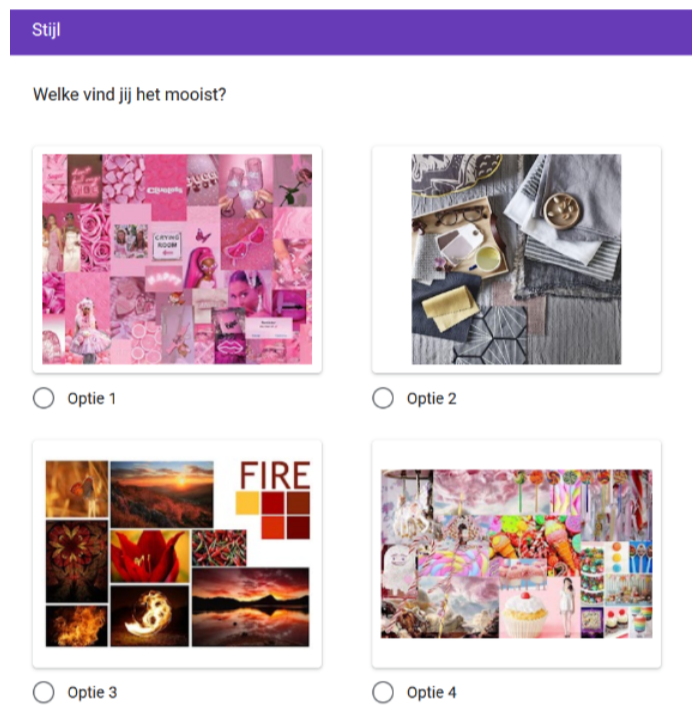
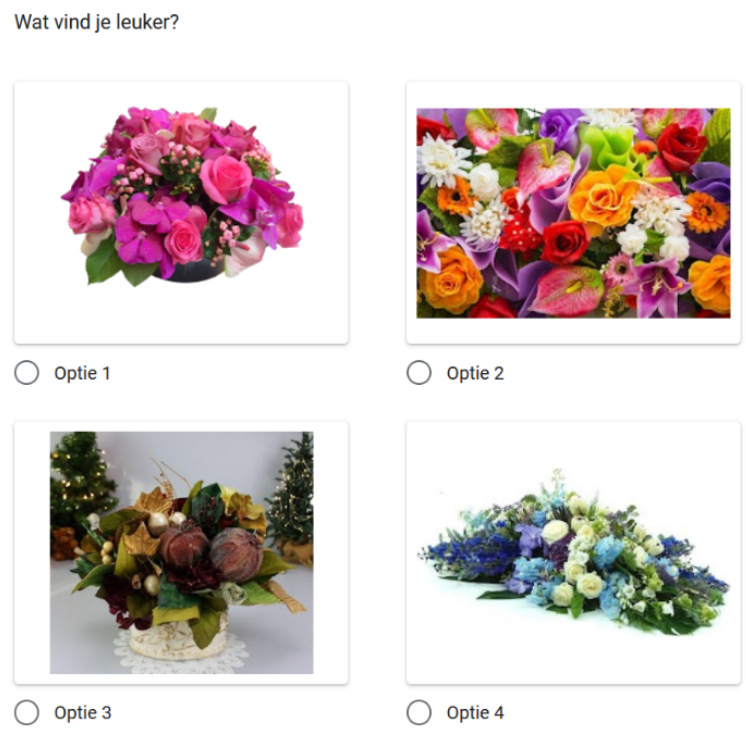
During phase 1, it was very noticeable that Laura struggled with answering open-ended questions. She would respond with “I don’t know” to almost every question, or would just agree with the given examples, which made it hard to understand her thoughts and feelings. To help Laura express herself better, a Google Forms was made, consisting of multiple-choice questions which had pre-defined options for her to choose from. This way Laura could respond with a clear “yes” or “no”, which gave a better understanding of her perspective, emotions and thoughts.
A few examples of the given questions can be found above. All questions are unfortunately in Dutch since Laura doesn’t understand the English language.
These questions were in the beginning about what kind of activities Laura likes to do, and which activities she doesn’t like to do. The later questions were a little bit about what she likes in terms of style.
2. Moodboard
To get a better understanding of the case owner’s style, the tool Pinterest was used in a form of co-design. As earlier stated, the case owner has difficulty understanding her feelings and making decisions. Though, one way that she can make decisions is by choosing between options. Therefore, the method of this form of co-design is:
- Make new Pinterest (not biased)
- Give the task to choose pictures that are appealing to her.
- Show theme/topic.
- Ask if she wants more of this topic or to go the next topic/theme.
- Show final number of picture and ask if she wants to delete a picture.
- Ask which ones are her favourites.
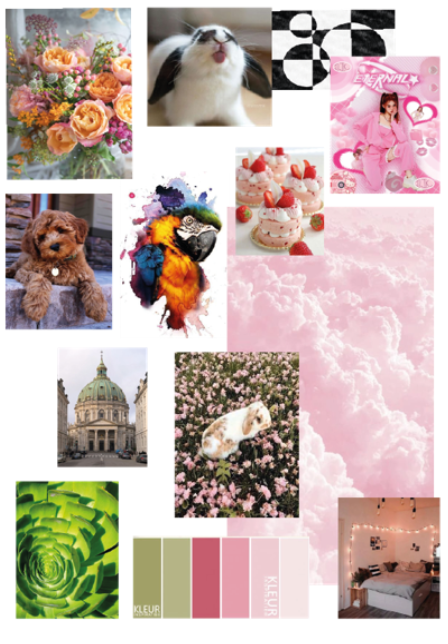
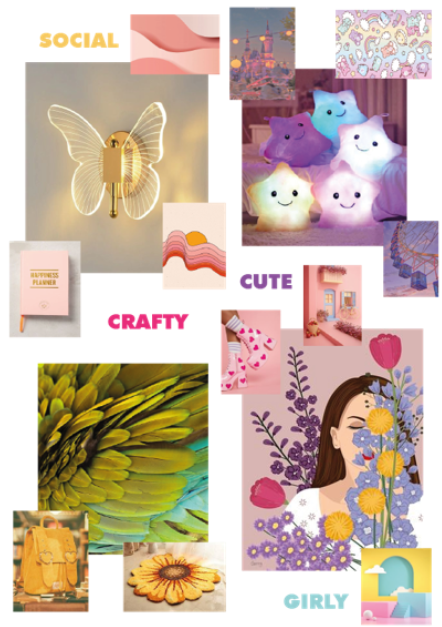
Laura’s moodboard pictures
Laura’s style collage
The left is an overview of the case owners chosen pictures. On the right our interpretation of the style is put together in a style collage. This style collage shows pictures the case owner relates to the most in our opinion. This style collage was kept in mind the entire process of making the concept.
3. First Prototype
A third way of co-design that was used is prototype testing with the case owner. The prototype is a mini version of the concept idea. There are three possible ‘solutions’ that can resolve the problem as defined in phase one. The first one is a reminder for the case owner to help realise and rethink decisions if it is necessary to text. The reminder is shown as the flower in the phone case. This place is chosen so that if the case owner is about to do the texting, she will get reminded of her actions. The second one is a bunny which is some sort of reward, that if the texting behaviour was good, a reward will be given at the end of the weekend. This is the small phone accessory shown below. The third one is an alternative outlet for the texting. This is done with a small activity list in the phone case, so that after the reminder and reasoning of the actions the case owner might feel more inspired to do either one of these activities.
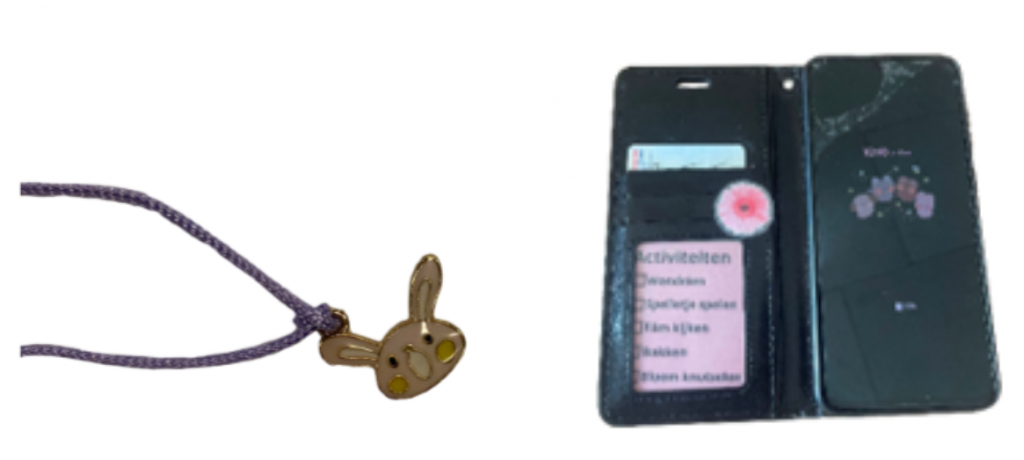
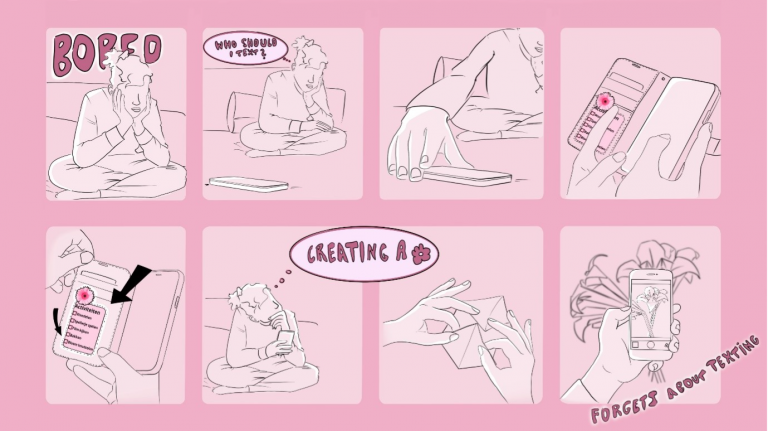
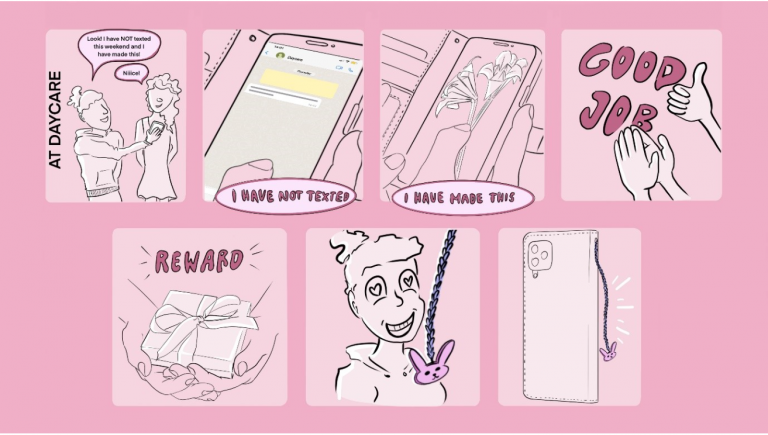
This scenario above shows the expected interaction with the prototype.
Evaluation prototype
Unfortunately, the flower got lost very early in the weekend. Laura forgot about the list, and she did not bring her phone charger, so her phone was dead for most part of the weekend. She did do an activity from the activity list but did not take a picture. Doing the activity from the list was a coincidence since she was going to do that activity anyway. Although she didn’t take a picture, she did spend almost no time on her phone for which the reward was given to her. She was very enthusiastic about her reward.
Based on the testing of the prototype, a new suggested prototype/concept was created. The activity list was not a great succes because Laura forgot about it. Therefore, the idea came up to make the actual activity. It is important that this activity fulfills the same feeling Laura gets with the texting. Multiple ideas arised such as a chatbot, burning phone or diary. Although she lost the reminder, it could still be a good idea to have it. The reminder should be designed such that it is impossible for Laura to lose it. Because the reward seemed to work and recieved positive reaction, the reward will also be kept in the suggested prototype.
Suggested prototype
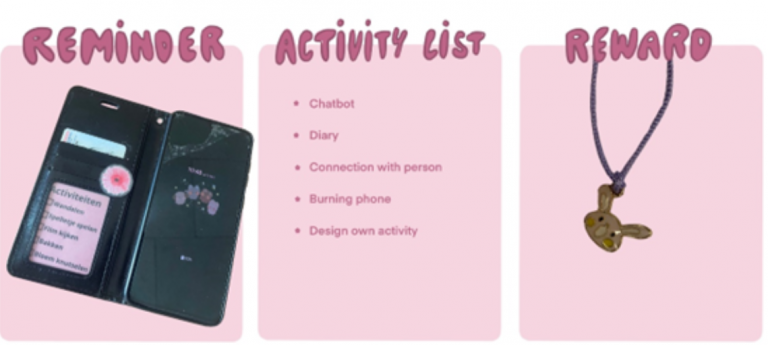
Problem definition phase 2
The problem is divided into three parts.
- Prevent the texting behaviour
- Provide alternative outlet for the case owner
- Positively enhance change in behaviour
The reasoning of the behaviour of the case owner is still unclear. The behaviour happens in the weekend outside the sight of the day-care. The day-care is bothered by the behaviour as they are the ones being texted. The texting itself is not a problem for the case owner, just the consequences it will bring along with it. However, providing a positive outlet for the case owner might help her with avoiding the texting.
Design challenge phase 2
“Our design challenge is to develop an interactive, physical product which reminds and rewards our co-designer with a goal to satisfy her needs and provide an outlet instead of (over)texting.”
One concern is that it is not fully clear what the reason is for the texting. Therefore, it is challenging to understand and get a better grip on the thinking process of the actions. This way it is still a challenge to create an activity that will fulfil the needs of the case owner instead of the texting.
Brainstorm session
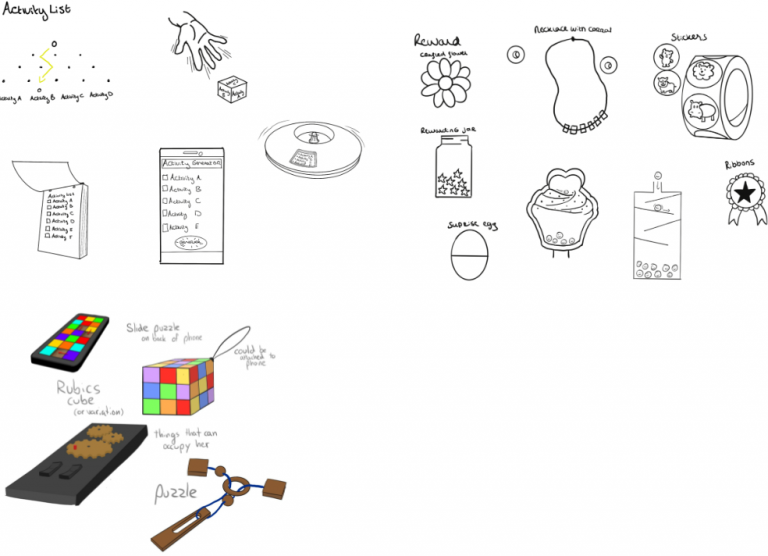
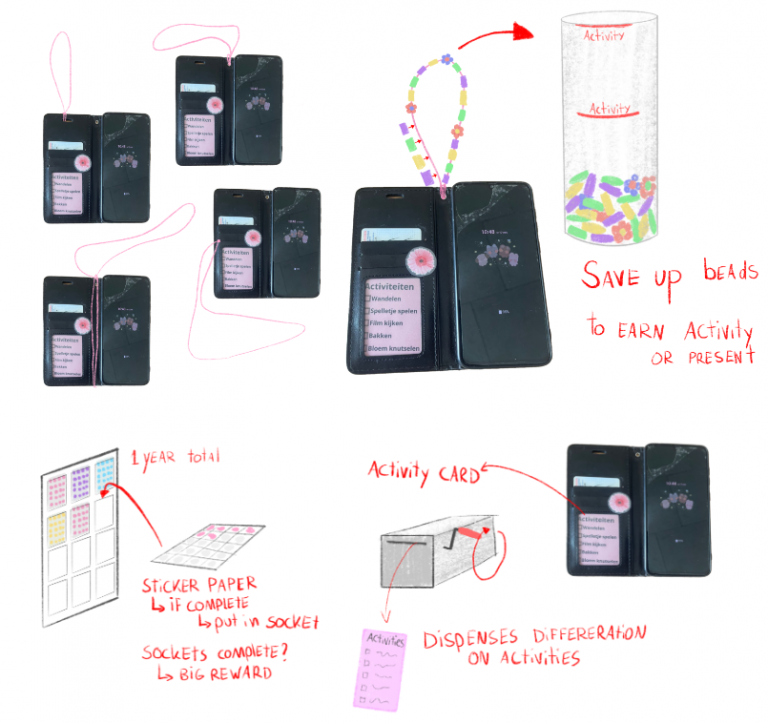
The brainstorming and ideation above is on how to make the bridge from the things the case owner like to a physical product. There is looked at how the themes such as pink and flowers can be integrated. Additionally, some shape and game ideation are done. The ideation also shows how the product can go all work to the one big reward and how the reward can be made interactive.
The concept
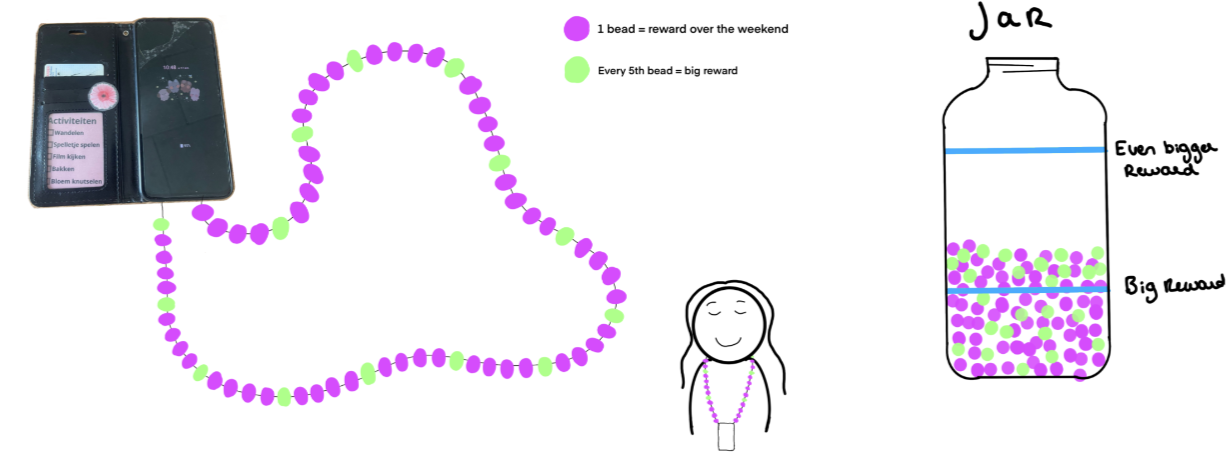
The final concept is aimed to work over a longer period of time, preferably over a span of at least a year. The solution of the concept is only focussed on the over-texting in the weekends. Therefore, there indicates 52 different rewards. To keep motivation over these weeks, these weeks are divided over small and big rewards. There is one big event to work towards in the end, but there are also small events/rewards during the year. The case owner will receive a smaller reward every four beads. One bead can be received by succeeding for one weekend without texting. A smaller reward for every five rewards is a small activity, which could be:
- Getting ice-cream
- Baking cake
- Watching a movie
The string attached to the phone has the use of a phone cable. This way the phone can be easily carried around. The beads Laura receives can be put onto this cord easily. This way the beads help the case owner remind of the reward and therefore remind not to text. Besides the beads being a reminder, there is also a specific flower on the inside of the phone case. This flower is the same flower as the printed flower on the beads.
On the inside of the phone case is also an activity list which the case owner can do instead of texting. This way the case owner has inspiration to something differently instead of the texting. Although this concept still contains the activity list, in the next phase more brainstorming will be done to improve the alternative outlet.